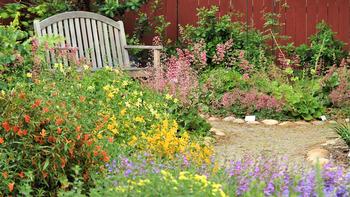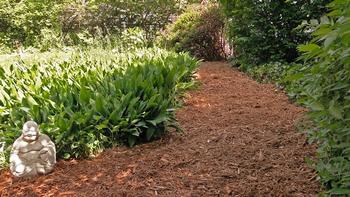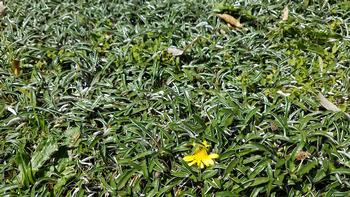Water balance for our plants
-
Dot Zanotti Ingels
-
We know our plants are living things and all living things on Earth require water to survive. Of course, plants cannot travel about in search of a drink, so they have evolved specific components of their structure to ensure adequate levels of hydration under various conditions. There are also things we can do to help.
 Native plants not only help conserve water but they support local pollinators. Photo: Jeff Silva
Native plants not only help conserve water but they support local pollinators. Photo: Jeff SilvaPlants take in carbon dioxide and water from the air and soil. All green plants have a pigment called chlorophyll where photosynthesis occurs. During photosynthesis, water is oxidized, losing electrons, and carbon dioxide is reduced, gaining electrons. This process transforms the water into oxygen, and carbon dioxide into glucose, which provides energy the plant needs to produce cellulose and starch.
Water and minerals are moved within the plant through a vascular conducting tissue of the plant called the xylem. The xylem distributes the water and dissolved minerals upward through the plant, from the roots to the leaves. Phloem is the other vascular tissue transporting the food created during photosynthesis downward from the leaves to the roots.
The amount of water the plant consumes is driven by the amount of water vapor it loses through its stomata, which are tiny pores on the undersides of the leaves. This water loss is called transpiration, and it’s how plants breathe.
As you can imagine, the amount of transpiration varies by geography and over time. Several factors determine transpiration rates: Mulch is an easy way to conserve water and reduce weeds in your garden. Photo: Maia C
Mulch is an easy way to conserve water and reduce weeds in your garden. Photo: Maia C- Temperature: Transpiration rates go up as the temperature rises, particularly during the growing season when the air is warmer due to longer and stronger sunlight, longer daylight hours and warmer air masses. The plant’s stoma cells open to release moisture with higher temperatures.
- Relative humidity: As the relative humidity of the air surrounding the plant rises, the transpiration rate falls. Water evaporates more easily into dryer air.
- Available soil moisture: When there is no available water, plants begin to prematurely age, resulting in leaf loss and significant plant stress.
How can we apply all this knowledge to keep our gardens water-wise? Save water by reducing the size of your lawn or consider a lawn alternative like Dymondia. Photo: Stephanie Falzone
Save water by reducing the size of your lawn or consider a lawn alternative like Dymondia. Photo: Stephanie Falzone- Plant selection and maintenance: Choose plants adapted to our climate and your specific microclimate. Drought-resistant natives are always a good choice, but many non-natives do well on the same amount of water. Group plants together that have similar watering requirements. Feed conservatively to keep plant size smaller and less thirsty. Pruning shrubs means they need less water.
- Reduce lawn turf areas: Consider replacing or reducing lawns. Grass is a heavy water user. There is a growing list of lawn alternatives like native grasses, groundcovers, and other ornamental grasses that use less water.
- Mulch: Mulching on top of the soil helps to reduce water evaporation, minimize weeds, and buffer soil temperatures. Weeds are thirsty so take the time to keep your yard weed-free.
- Monitor your water bill: Unexpectedly high water bills may indicate a leak in your irrigation system, which requires maintenance. At least once a month, turn each of your irrigation stations on manually and observe what’s happening in the garden.
- Irrigate properly: Many drought-adapted native trees can manage with irrigation just once or twice during the growing season during drought and may not need any irrigation at all during abundant rainfall years. Drip irrigation places water more efficiently in the root zone and minimizes wasteful runoff. Try watering trees and shrubs using a soaker hose or drip irrigation to apply a consistently low flow of water over a more extended period. Watering early in the morning avoids heavy evaporation.
- UC Marin Master Gardeners and the Marin Municipal Water District have teamed up to offer Marin homeowners a free service called Marin-friendly Garden walks. Invite us to visit, and we will provide you with information and advice on improving your irrigation practices to help conserve Marin’s precious water resources. For more information and to schedule a Garden Walk, please visit our Marin-friendly Garden Walks page.



